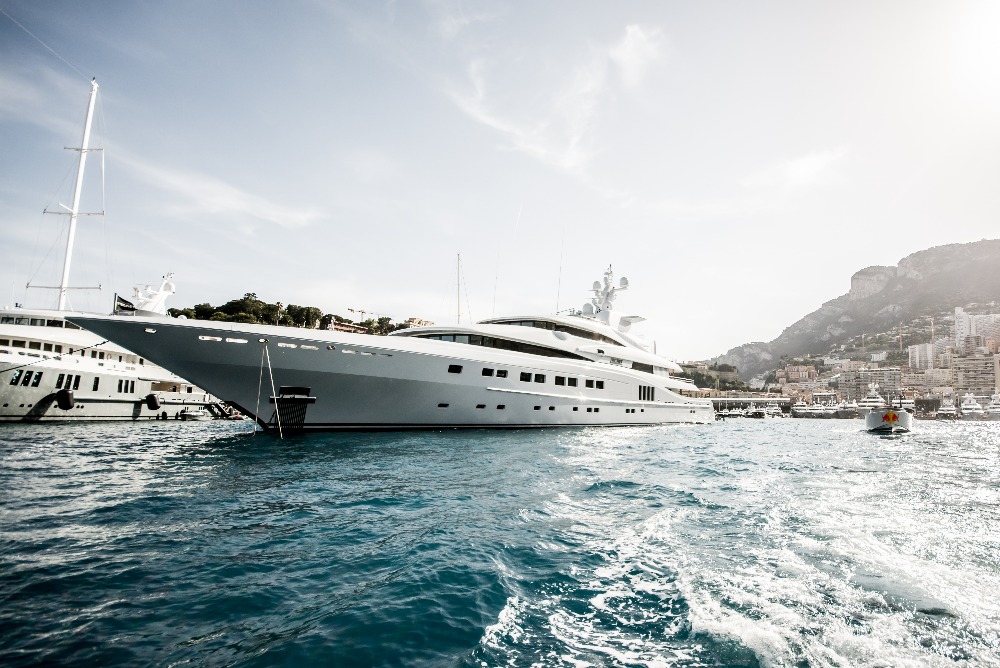People, Planet, Paint
We explore how yacht coatings contributes to AkzoNobel's financial and sustainability goals…
Following AkzoNobel’s Q2 financial results, which highlighted growth in revenue of 26 per cent and a €335million adjusted operating income, as well as the business setting out its carbon reduction targets to help tackle climate change, SuperyachtNews explores how the superyacht coatings business fits into the wider corporate strategy and success.
“The yacht coatings business is inextricably linked to the strategy of AkzoNobel, as well as the key pillars that support that strategy, such as the various sustainability initiatives,” starts Bilal Salahuddin, global business director of yacht coatings at AkzoNobel. “This portion of the business has always been considered one of the technologically leading businesses within the wider organisation. We also look at each individual business and consider where we stand from a relative market perspective. In the instances that we are market leaders, such as within yacht coatings, it becomes all the more important that we are driving the right messages and leading the market forward.”
According to AkzoNobel’s Q2 results, revenue for Q2 in 2020 is 26 per cent higher than in Q2 2020 and up eight per cent when compared with Q2 2019.
“The company has been in very strong financial health for the last two years and at an improving trajectory. We had our stated ambitions of 15 by 20, which was a profitability ambition to reach for the year 2020, which we achieved despite the headwinds caused by COVID,” continues Salahuddin. “That was an extremely proud moment for our 30,000-plus employees across the globe. The company then announced a growing global strategy for the coming three years and we have started on an extremely strong footing.”
The yacht coatings business has always been considered a growth-oriented segment within AkzoNobel, explains Salahuddin. While 2020 was obviously a difficult year in terms of volume and top-line results, 2021 has started extremely strongly for yacht coatings, driven partially by the global uptick in yacht sales, both second-hand and new.
“Most industries and most companies within coatings saw challenges to their top lines in 2020, as did we, but we focussed on maintaining and supporting the business and ensuring support for and the health of our employees and customers by creating a safe working environment,” explains Salahuddin. “That being said, broadly speaking 2020 was a strong year for yacht coatings and it contributed significantly to the 15 by 20 ambition of AkzoNobel.”
In addition to announcing its results and growth aspirations, AkzoNobel also recently announced new targets for its People, Planet, Paint sustainability initiative, which was launched in 2019. AkzoNobel’s target is to reduce carbon emissions for the whole value chain by 42 per cent by 2030, taking 2020 as its baseline year. This will apply to the company’s own operations, as well as its partners, such as customers and suppliers.
“Setting a target like this really matters,” says AkzoNobel’s CEO, Thierry Vanlancker. “It’s a clear signal that we’re preparing to mobilise our teams globally and take stronger action to tackle climate change. We need to act fast and focus on collaboration and innovation. When push comes to shove, there are those who contribute towards a zero-carbon future and those who don’t. We’re determined to do all we can and set the example by being the frontrunner in our industry.”
“For People, the important thing is to ensure that we have a sustainable workforce and that we are responsible in the countries and markets that we operate within,” continues Sallahudin. “In other words, we support diversity and inclusion, and providing good employment conditions to our people, as well as taking care of them throughout COVID.”
Where the Planet is concerned, AkzoNobel as a coatings manufacturer is acutely aware that it has a footprint that requires managing. Central to its initiative is the aforementioned 42 per cent reduction in carbon emissions and a desire to be operating off 100 per cent renewable energy for its European operations.
“For the yachting business, more than 50 per cent of our production for coatings takes place in Europe. With our main facilities in the UK and the Netherlands, we are moving towards renewable energy,” comments Sallahudin. “Many of our products, including our top coats, are already being made with renewable energy and we have the ambition of moving 100 per cent of yachting production to renewable energy within two years, as well as many of our plants already recycling water.”
In terms of paint, AkzoNobel’s yachting coatings business has a very direct impact on the development of the wider organisations sustainable initiatives.
“There are many things that not only affect yacht coatings, but coatings in general, like pigments, solvents and binders,” explains Sallahudin. “Equally, with technology, there are a lot of things that you can influence. For instance, there are elements of the process for paint application that are part of the umbrella and we are heavily contributing there.”
Sallahudin references AkzoNobel’s Awlfair Spray Filler (SF) product that is aiming to revolutionise how filler is applied to superyachts. In partnership with a number of businesses, including Pinmar and Wrede Consulting from the yachting world, AkzoNobel has created an application process that has completely changed a process that has been common practice for a number of years. The new process helps with time savings, it reduces waste, produces fewer particles in the air and creates a more friendly environment for applicators to work in.
“As a business director, I can tell you that the investment required to commercialise this development is significant, but we are committed to driving the industry forward,” continues Sallahudin. “This is the responsibility of being a market leader. We want to encourage our competitors to do the same if they come and replicate the technology. The whole industry is better off, it is better for us, it is better for the applicators, it is better for the shipyards and it is better for the environment.”
Awlfair SF is just one example of how AkzoNobel is trying to make its paint solutions more sustainable. Other examples include moving towards water-based products, copper-free formulas and biocide-free solutions, with aid from R&D departments throughout the organisation.
As a market leader, it is clear the AkzoNobel takes both the growth and sustainability of the business incredibly seriously. By not just focussing on the environment, AkzoNobel has confirmed its commitment to improving and protecting its human resources and safeguarding the future efficacy of its products.
Profile links
NEW: Sign up for SuperyachtNewsweek!
Get the latest weekly news, in-depth reports, intelligence, and strategic insights, delivered directly from The Superyacht Group's editors and market analysts.
Stay at the forefront of the superyacht industry with SuperyachtNewsweek
Click here to become part of The Superyacht Group community, and join us in our mission to make this industry accessible to all, and prosperous for the long-term. We are offering access to the superyacht industry’s most comprehensive and longstanding archive of business-critical information, as well as a comprehensive, real-time superyacht fleet database, for just £10 per month, because we are One Industry with One Mission. Sign up here.
Related news

Consolidating through investment
How OceanTech Acquisitions, the special-purpose acquisition company, intends to capitalise the shipyard market and bring about an era of consolidation
Business

The evolving issue of bridge complexity
TEAM Italia discusses how bridge integrators ensure configurations remain safe and user-friendly
Technology

Is 'hybrid' just a cool word?
Is hybrid propulsion the future or just a stepping stone on the journey to becoming emission free?
Technology

Mind your language
Does yachting’s dedication to heritage and traditional language hold it back?
Owner

Optimising the refit experience with Amico & Co.
Amico & Co and Captain Alasdair Jones offer insight into how to improve the refit process
Crew

Forging a future for hybrid adoption
Why has the uptake in hybrid propulsion solutions been slower than their perceived popularity would suggest?
Technology
Related news
Consolidating through investment
4 years ago
The evolving issue of bridge complexity
4 years ago
Is 'hybrid' just a cool word?
4 years ago
Mind your language
4 years ago
Optimising the refit experience with Amico & Co.
4 years ago
Forging a future for hybrid adoption
4 years ago
NEW: Sign up for
SuperyachtNewsweek!
Get the latest weekly news, in-depth reports, intelligence, and strategic insights, delivered directly from The Superyacht Group's editors and market analysts.
Stay at the forefront of the superyacht industry with SuperyachtNewsweek




